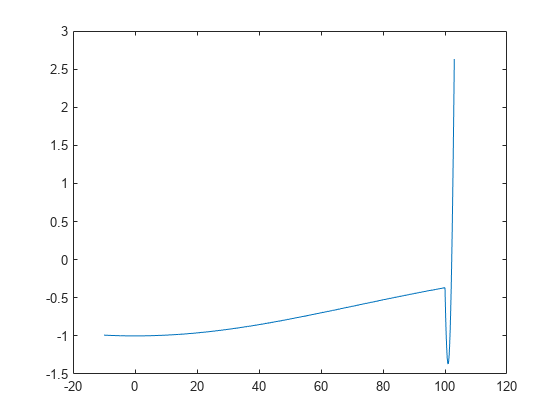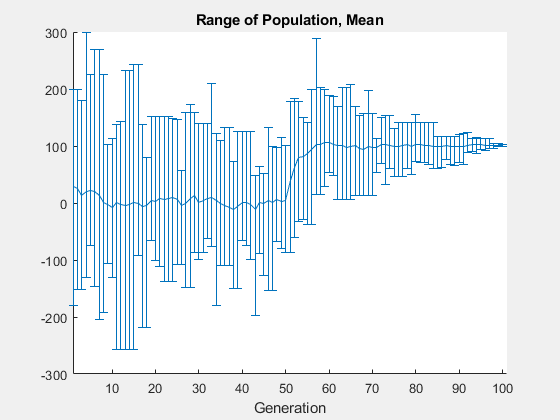使用 ga 进行全局优化与局部优化
寻找全局最小值
有时,优化的目标是找到函数的全局最小值或最大值-函数在搜索空间中的任何其他点都小于或大于该点。然而,优化算法有时会返回局部最小值-该点的函数值小于附近点,但可能大于搜索空间中远处点的函数值。遗传算法有时可以通过正确的设置来克服这一缺陷。
作为示例,考虑以下函数。
绘制函数。
t = -10:.1:103; for ii = 1:length(t) y(ii) = two_min(t(ii)); end plot(t,y)

该函数有两个局部极小值,一个在 ,其中函数值为 -1,另一个在 ,其中函数值为 。由于后者的值较小,全局最小值出现在 处。
使用默认参数运行 ga
two_min 辅助函数的代码位于本示例的末尾。使用默认参数运行 ga 以最小化 two_min 函数。使用 gaplot1drange 辅助函数(包含在此示例的末尾)绘制每次迭代时 ga 种群的范围。
rng default % For reproducibility options = optimoptions('ga','PlotFcn',@gaplot1drange); [x,fval] = ga(@two_min,1,[],[],[],[],[],[],[],options)
ga stopped because the average change in the fitness value is less than options.FunctionTolerance.

x = -0.0688
fval = -1.0000
遗传算法返回一个非常接近 局部最小值的点。请注意,所有个体都位于 -60 至 60 之间。种群从未探索 处全局最小值附近的点。
增加初始范围
使遗传算法探索更大范围的点(即增加种群的多样性)的一种方法是增加初始范围。初始范围不必包含点 x = 101,但它必须足够大,以便算法在 x = 101 附近生成个体。将 InitialPopulationRange 选项设置为 [-10;90] 并重新运行求解器。
options.InitialPopulationRange = [-10;90]; [x,fval] = ga(@two_min,1,[],[],[],[],[],[],[],options)
ga stopped because it exceeded options.MaxGenerations.

x = 100.9783
fval = -1.3674
这一次,自定义图表展现的个体范围更加广泛。从一开始就有接近 101 的个体,并且种群平均值开始收敛到 101。
辅助函数
以下代码创建 two_min 辅助函数。
function y = two_min(x) if x <= 100 y = -exp(-(x/100)^2); else y = -exp(-1) + (x-100)*(x-102); end end
以下代码创建 gaplot1drange 辅助函数。
function state = gaplot1drange(options,state,flag) %gaplot1drange Plots the mean and the range of the population. % STATE = gaplot1drange(OPTIONS,STATE,FLAG) plots the mean and the range % (highest and the lowest) of individuals (1-D only). % % Example: % Create options that use gaplot1drange % as the plot function % options = optimoptions('ga','PlotFcn',@gaplot1drange); % Copyright 2012-2014 The MathWorks, Inc. if isinf(options.MaxGenerations) || size(state.Population,2) > 1 title('Plot Not Available','interp','none'); return; end generation = state.Generation; score = state.Population; smean = mean(score); Y = smean; L = smean - min(score); U = max(score) - smean; switch flag case 'init' set(gca,'xlim',[1,options.MaxGenerations+1]); plotRange = errorbar(generation,Y,L,U); set(plotRange,'Tag','gaplot1drange'); title('Range of Population, Mean','interp','none') xlabel('Generation','interp','none') case 'iter' plotRange = findobj(get(gca,'Children'),'Tag','gaplot1drange'); newX = [get(plotRange,'Xdata') generation]; newY = [get(plotRange,'Ydata') Y]; newL = [get(plotRange,'Ldata') L]; newU = [get(plotRange,'Udata') U]; set(plotRange,'Xdata',newX,'Ydata',newY,'Ldata',newL,'Udata',newU); end end